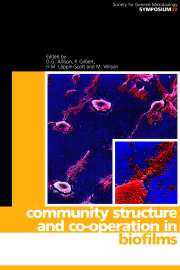Book contents
- Frontmatter
- Contents
- Contributors
- Editors' Preface
- An overview of biofilms as functional communities
- Initial microbial adhesion events: mechanisms and implications
- Physiological events in biofilm formation
- Environmental and genetic factors influencing biofilm structure
- Coaggregation and coadhesion in oral biofilms
- Cohesiveness in biofilm matrix polymers
- Microbial detachment from biofilms
- Modelling and predicting biofilm structure
- Microbial community interactions in biofilms
- Microbial communities: aggregates of individuals or co-ordinated systems
- Gene transfer in biofilms
- Population dynamics in microbial biofilms
- Biodegradation by biofilm communities
- Biofilms and prosthetic devices
- Biofilms: problems of control
- Biofilms in the New Millennium: musings from a peak in Xanadu
- Index
Biodegradation by biofilm communities
Published online by Cambridge University Press: 03 June 2010
- Frontmatter
- Contents
- Contributors
- Editors' Preface
- An overview of biofilms as functional communities
- Initial microbial adhesion events: mechanisms and implications
- Physiological events in biofilm formation
- Environmental and genetic factors influencing biofilm structure
- Coaggregation and coadhesion in oral biofilms
- Cohesiveness in biofilm matrix polymers
- Microbial detachment from biofilms
- Modelling and predicting biofilm structure
- Microbial community interactions in biofilms
- Microbial communities: aggregates of individuals or co-ordinated systems
- Gene transfer in biofilms
- Population dynamics in microbial biofilms
- Biodegradation by biofilm communities
- Biofilms and prosthetic devices
- Biofilms: problems of control
- Biofilms in the New Millennium: musings from a peak in Xanadu
- Index
Summary
INTRODUCTION
It has been shown that microbial communities contribute extensively to the attenuation, mineralization and transport of both organic and inorganic contaminants in the environment. The development of biofilms by microbial communities is often a key factor contributing to the overall efficiency of these processes (Rothemund et al., 1996). For instance, bacterial biofilms are able to accumulate metals through various mechanisms (Marques et al., 1991; Sillitoe et al., 1994). Liehr et al. (1994) showed that biofilms formed by algae could concentrate metals at levels more than four orders of magnitude higher than those in the surrounding water.
The potential of bioremediation as an alternative to physical and chemical remediation strategies has resulted in a significant amount of research effort on degradative biofilms. Although much emphasis has been placed on the degradation of xenobiotic compounds, the knowledge gained through these studies has also contributed to an improved understanding of processes involved in the degradation of naturally occurring molecules as well as nutrient cycling in general. Tank & Webster (1998) suggested that competition for nutrients might regulate heterotrophic microbial processes in natural streams. In their study, they found that nutrient immobilization by leaves partially inhibited other heterotrophic processes, as evidenced by low microbial respiration, fungal biomass and extracellular enzyme activity among wood biofilms in the presence of leaf litter. Lawrence et al. (1998) stressed the applicability of knowledge gained through the study of naturally occurring attenuation mechanisms to remediating contaminated environments. Clearly, the study of degradative biofilms is of both fundamental and applied interest.
- Type
- Chapter
- Information
- Community Structure and Co-operation in Biofilms , pp. 279 - 294Publisher: Cambridge University PressPrint publication year: 2000



